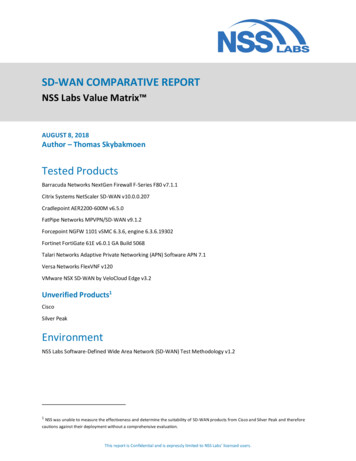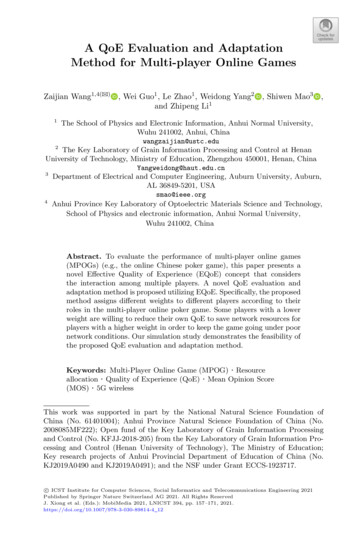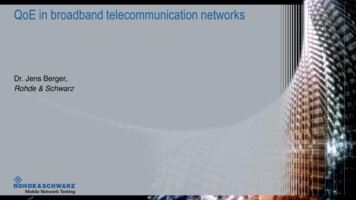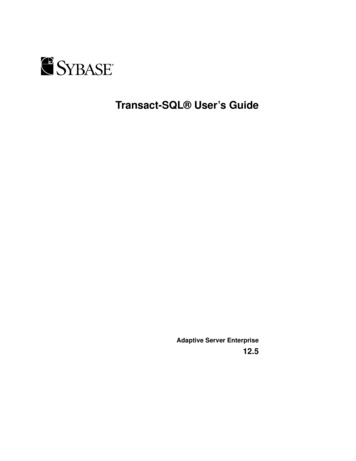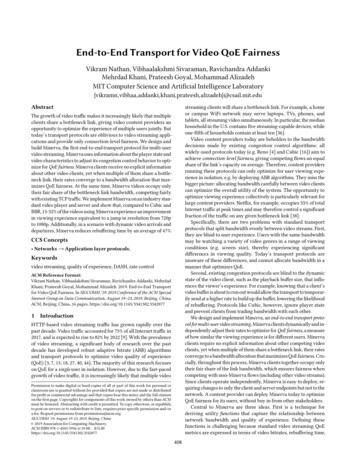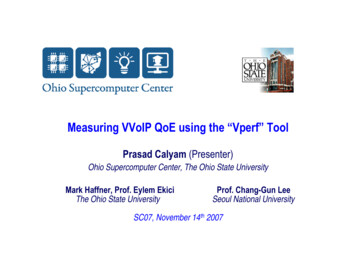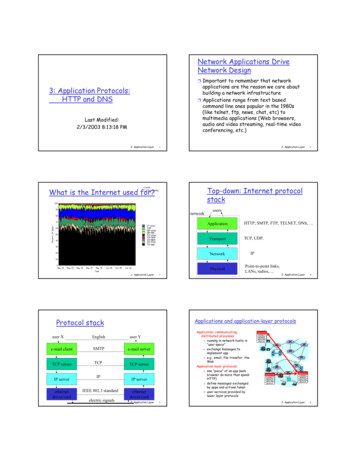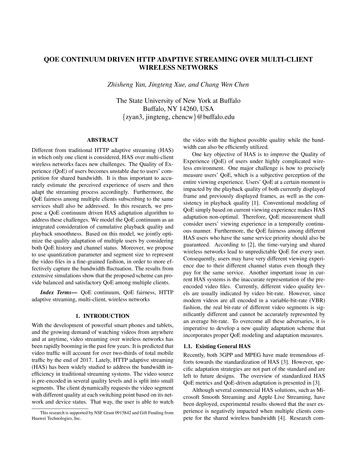
Transcription
QOE CONTINUUM DRIVEN HTTP ADAPTIVE STREAMING OVER MULTI-CLIENTWIRELESS NETWORKSZhisheng Yan, Jingteng Xue, and Chang Wen ChenThe State University of New York at BuffaloBuffalo, NY 14260, USA{zyan3, jingteng, chencw}@buffalo.eduABSTRACTDifferent from traditional HTTP adaptive streaming (HAS)in which only one client is considered, HAS over multi-clientwireless networks faces new challenges. The Quality of Experience (QoE) of users becomes unstable due to users’ competition for shared bandwidth. It is thus important to accurately estimate the perceived experience of users and thenadapt the streaming process accordingly. Furthermore, theQoE fairness among multiple clients subscribing to the sameservices shall also be addressed. In this research, we propose a QoE continuum driven HAS adaptation algorithm toaddress these challenges. We model the QoE continuum as anintegrated consideration of cumulative playback quality andplayback smoothness. Based on this model, we jointly optimize the quality adaptation of multiple users by consideringboth QoE history and channel status. Moreover, we proposeto use quantization parameter and segment size to representthe video files in a fine-grained fashion, in order to more effectively capture the bandwidth fluctuation. The results fromextensive simulations show that the proposed scheme can provide balanced and satisfactory QoE among multiple clients.Index Terms— QoE continuum, QoE fairness, HTTPadaptive streaming, multi-client, wireless networks1. INTRODUCTIONWith the development of powerful smart phones and tablets,and the growing demand of watching videos from anywhereand at anytime, video streaming over wireless networks hasbeen rapidly booming in the past few years. It is predicted thatvideo traffic will account for over two-thirds of total mobiletraffic by the end of 2017. Lately, HTTP adaptive streaming(HAS) has been widely studied to address the bandwidth inefficiency in traditional streaming systems. The video sourceis pre-encoded in several quality levels and is split into smallsegments. The client dynamically requests the video segmentwith different quality at each switching point based on its network and device status. That way, the user is able to watchThis research is supported by NSF Grant 0915842 and Gift Funding fromHuawei Technologies, Inc.the video with the highest possible quality while the bandwidth can also be efficiently utilized.One key objective of HAS is to improve the Quality ofExperience (QoE) of users under highly complicated wireless environment. One major challenge is how to preciselymeasure users’ QoE, which is a subjective perception of theentire viewing experience. Users’ QoE at a certain moment isimpacted by the playback quality of both currently displayedframe and previously displayed frames, as well as the consistency in playback quality [1]. Conventional modeling ofQoE simply based on current viewing experience makes HASadaptation non-optimal. Therefore, QoE measurement shallconsider users’ viewing experience in a temporally continuous manner. Furthermore, the QoE fairness among differentHAS users who have the same service priority should also beguaranteed. According to [2], the time-varying and sharedwireless networks lead to unpredictable QoE for every user.Consequently, users may have very different viewing experience due to their different channel status even though theypay for the same service. Another important issue in current HAS systems is the inaccurate representation of the preencoded video files. Currently, different video quality levels are usually indicated by video bit-rate. However, sincemodern videos are all encoded in a variable-bit-rate (VBR)fashion, the real bit-rate of different video segments is significantly different and cannot be accurately represented byan average bit-rate. To overcome all these adversaries, it isimperative to develop a new quality adaptation scheme thatincorporates proper QoE modeling and adaptation measures.1.1. Existing General HASRecently, both 3GPP and MPEG have made tremendous efforts towards the standardization of HAS [3]. However, specific adaptation strategies are not part of the standard and areleft to future designs. The overview of standardized HASQoE metrics and QoE-driven adaptation is presented in [3].Although several commercial HAS solutions, such as Microsoft Smooth Streaming and Apple Live Streaming, havebeen deployed, experimental results showed that the user experience is negatively impacted when multiple clients compete for the shared wireless bandwidth [4]. Research com-
munities have also proposed several HAS rate adaptation algorithms [5–7]. However, these algorithms are targeted atsingle-user and client-side adaptation. They cannot be directly applied to the multi-client wireless networks since theyare unaware of QoE fairness. The proposed framework, instead, shifts the adaptation to the base station that can jointlyadapt the video quality and optimize the QoE of multipleclients without modifying the standard HAS framework.Only few work has been focused on HAS for multi-clientwireless networks. In [4], the authors first identified the issues in multi-client wireless networks and proposed a simpletraffic shaping mechanism to improve the experience of twocompeting users. In [8], the authors enhanced the QoE bymaximizing the overall mean opinion score (MOS) that is decided by the selected bit-rate and content of the video. Nevertheless, the QoE model is not accurate enough since only theviewing experience at the adaptation moment is considered.1.2. Existing QoE-driven HASQoE has been studied in the design of several HAS systems.QDASH [1] improved the HAS adaptation by incorporatinga intermediate level into the switching process. However, noexplicit model is provided for QoE measurement, which limits its application to different HAS systems. In [9], an adaptation proxy located at the edge of the wired network wasproposed to maximize user average data rate and minimizethe rate variation and delay jitter. However, the algorithmis essentially QoS-driven and the standard HAS frameworkis modified due to the use of split-TCP. Although the workin [10] revealed the importance of temporal factors for QoEby studying the jitter and local content, the necessity of human intervention makes it difficult to be generally deployed.1.3. Summary and ContributionsIn summary, although aforementioned works have made contributions to the HAS development, none of them thoroughlystudies the impacts of QoE continuum (namely previous playback quality, current playback quality, and playback qualityvariation) on HAS quality adaptation, and the QoE fairnessamong multiple clients in wireless environment. The major contribution of this research is that we propose a qualityadaptation algorithm that can guarantee both QoE and fairness in one shared cell with multiple clients by exploitingthe nature of human perception and video source. Specifically, we model the QoE continuum by considering bothcumulative playback quality and playback smoothness. Byexploiting the proposed model, the base station can jointlyoptimize the video quality levels of multiple HAS users under bandwidth-limited cellular networks, in order to fairlymaximize all users’ QoE. Moreover, we propose to adoptfine-grained video representations that characterize the videoquality levels by a tuple of file size and quantization parameter (QP), in order to capture video source characteristics andthen execute more efficient quality adaptation. More importantly, the proposed algorithm is standard-friendly since ,!S1M.QPX1,!SX1.QPX2,!SX2. . ENNode"BGGSNRNCFig. 1. System Architecturebase station only need to modify the clients’ requests to accommodate the QoE and fairness driven adaptation.The rest of this paper is organized as follows. In Section2, we describe the system models. In Section 3, the proposedquality adaptation algorithm is introduced. We then evaluatethe performance of proposed algorithm and present the resultsin Section 4. Finally we conclude this paper in Section 5.2. SYSTEM MODEL2.1. System ArchitectureIn this research, we consider the system architecture as shownin Fig. 1. The HAS server stores several VBR videos that allhave M levels of quality. Each level of video is split intomultiple video segments with the same segment length andeach segment is characterized by the QP and segment file size,i.e., a tuple (QP, S).The proposed algorithm is designed for cellular networks,where the base station jointly optimizes the quality adaptation to ensure QoE continuum and fairness. Here we consider3G High-Speed Downlink Packet Access (HSDPA) networkas the underlying cellular network. However, the design principles are generic and the algorithm can be easily extended toother cellular networks such as LTE. We focus on the HASwithin one cell, where N users in the cell are managed byNode-B and each user is indexed by i, i 1, 2 · · · N . Weassume that one user can only establish one flow with theHAS server. The proposed algorithm is operated by Node-Band implemented on top of underlying scheduling algorithms.Hence, it is practical to apply it to the modern cellular networks without modifying lower-layer scheduling strategies.The quality adaptation is proceeded as follows. Initially,the HAS server sends out the media presentation descriptionso that Node-B and clients will have the knowledge of available video representations. At each adaptation period whoselength equals to segment length, clients request a specificvideo segment at a certain quality level based on a simplethroughput calculation, which requires very low complexity.Such operation is only used to be compatible with currentDASH standards. Hence, no local hardware or operating system optimization is needed. Rather than directly forwardingthe requests, however, Node-B in the proposed system will intercept the requests and modify the adaptation decisions basedon the proposed algorithm, where both low-layer link status(such as channel quality indicator (CQI)) and high-layer QoEand encoding information (such as current cumulative playback quality) are utilized to guarantee balanced QoE contin-
uum for all users. Such information are embedded in the periodic feedback from clients. Note that this is feasible since3GPP DASH standard has standardized the quality metricsreporting process for clients. It uses a HTTP POST as the reporting protocol. Thus users are able to enjoy the video withoptimized QoE while neither the client nor the HAS server isaware of the adaptation done by Node-B. Therefore, the proposed algorithm can be friendly implemented in current HASstandard framework.2.2. QoE Continuum ModelWe have identified that the QoE of HAS shall be measured ina timely continuous fashion. In this section, we introduce twofactors that impacts QoE continuum, i.e., cumulative playback quality (CPQ) and playback smoothness.2.2.1. Cumulative Playback QualityIt has been discovered by psychological research that humanmemory demonstrates an exponential decay with respect totime, which is called as forgetting curve effect. Such effecthas been suggested by ITU standard [11] to be applied incontinuous quality evaluation. Hence, we exploit this effectto model the CPQ. In [12], we have derived Qk , the CPQ atframe k, as the summation of instantaneous playback qualityover all displaying moments until the measure moment, i.e.,Qk γQk 1 (1 γ)qk(1)where Qk 1 is the CPQ at the previous frame, qk is the instantaneous playback quality at frame k, and γ is the characterization constant of the memory strength. Qk , qk and γall belong to (0,1]. That way, we can capture the QoE fromprevious displaying moments until the current moment.At a particular displaying moment of HAS systems, thevideo player can either playback one frame normally or freezeat a certain previous frame. Note that transmission distortionis disregarded in this research since HAS is virtually loss freedue to the underlying TCP mechanisms. For the moment withnormal playback, the instantaneous playback quality is dictated by the image quality of that frame. Thus we can predictimage quality from QP using a linear model and estimate theinstantaneous playback quality qk,play asqk,play aQPk b(2)where a and b are content-specific parameters.When the bit-rate of the streamed video for a user exceeds the user’s available bandwidth and the selected videohas not been downshifted to a lower quality, playback interruption may occur due to the client’s re-buffering. In thiscase, the video player’s screen will stall at the most recent displayed image and consequently the user will undergo certainloss of expected visual information. Thereby, we can reliablymodel and validate the instantaneous playback quality for aninterruption moment qk,stall as the visual information loss Lscaled by the instantaneous user expectation E [12], i.e.,qk,stall Lk Ek .(3)where Ek is signified by the playback quality of the last displayed frame j, i.e., Ek qj,play . Besides, Lk represents theresidual norm between expected frame and frame j in pixelrdomain, which is linearly approximated by j,play, whereηrj,play is the bit count of the last displayed frame j and ηis the compression ratio. To further describe the logarithmicrelation in rate distortion theory, we apply a logarithmic operation and then bound Lk in (0,1] as follows,Lk j log(min(rj,play , rQP )) clog(rQP ) c(4)where rQP is the upper bound of frame size with the specificQP, and c log(η)/2 is a model constant. The value of rQPcan be calculated online based on previous streaming information of decoded bits assuming that the size of frames witha fixed QP is governed by a Laplace distribution. This assumption is reasonable given the independent identically distributed property of compressed frames.2.2.2. Playback SmoothnessSubjective tests have shown that users prefer consistentlylow-quality video over the video that fluctuates between highquality and low quality [1]. By using the cumulative playback quality model in (1), the playback smoothness can beeffectively characterized in this research. Suppose one hasbeen enjoying the video with decent quality for a while (e.g.,Qk 1 0.9), the sudden quality degradation of the currentframe (e.g., qk 0.6) could lead to a decreased current CPQQk . Such degradation would be accumulated and eventuallycause annoy experience after the playback of an entire segment. The larger difference between the previous CPQ andthe instantaneous playback quality, the worse the current CPQwould be. That way, the proposed algorithm places a constraint on the quality adaptation so that abrupt quality changeis avoided and QoE continuum is improved. More importantly, due to the smooth quality variation of some users, resources can be saved for the other users who need them.3. PROPOSED QUALITY ADAPTATIONIn this section, we introduce the novel framework to exploitthe nature of QoE continuum and fine-grained video representations in order to fairly enhance the perceived experienceof users. We formulate the adaptation optimization problemand propose an effective solution to achieve improved QoEcontinuum and QoE fairness.3.1. Formulation of the OptimizationThe QoE of HAS systems is critically decided by whether ornot the data volume of the streamed segment is larger than thecurrently available bandwidth. It is necessary to incorporatethe channel condition into quality adaptation process, especially considering the time-varying nature of wireless channel. In typical HSDPA implementations, wireless resourcesare divided into Transmission Time Intervals during whichone user can receive its data packets. The maximum number
of data bits that can be received by user i per second, denotedas Ri,max , is essentially determined by the CQI of link i. At agiven switching point, we employ the mean CQI of link i during the last adaptation period to estimate Ri,max during thenext period by using the look-up table in 3GPP standard [13].Note that the mean CQI shall not be calculated based on atime interval that is too brief since it may not reflect the average channel status in the next updating period. Similarly,conservative mean CQI calculation using a long time intervalmay lead to slow adaptation to channel variation. Thus theresource sharing of user i, denoted by ϕi , is given byϕi SiT Ri,max(5)where we approximate the bit-rate of the selected video segment as the ratio between the file size and the segment length.Hence, the available channelP resource constraint for the proposed HAS system is i N ϕi 1, where N is set ofHAS users. Such joint consideration of shared bandwidth willmake the quality selection fair and reliable, and thus enhanceQoE continuum. This definitely cannot be accomplished byindividually blind client-side adaptation.According to the estimated maximum data rate, Node-Bis able to estimate the CPQ at the next switching point Qi,t Twhen a video quality level li,t T is considered. Node-B firstanalyzes the adaptation-related information, such as currentCPQ Qi,t and buffer status, as feedback received from clients.Then Qi,t T can be recursively calculated according to (1) bypredicting whether the player is playing or stalling at each display moment from t to t T . If user i is not re-buffering att, Qi,t T will be estimated from Qi,t by first considering thenormal playback of the remaining frames (quality level li,t )in the buffer and then considering the normal playback of theselected level li,t T for the rest of the period. If the user isre-buffering, Qi,t T will be first calculated by assuming thatthe player is frozen until the buffer size reaches the playbackthreshold. The interruption time is decided by the estimatedRi,max . Then Qi,t T will be further updated by assumingthe normal playback of video with level li,t T . That way,we can accurately estimate the cumulative user experience atnext switching point and assign the most satisfactory and fairadaptation decision to users accordingly. Note that interruption may happen in reality during the playback of level li,t Tdue to the channel estimation error.Based on the above analysis, we now can formulate an optimization to find the optimal level of video segment, which isindicated by a tuple (QP, S), for each user at switching pointt. We model the QoE continuum as a joint consideration ofthe playback quality and playback smoothness, i.e., the CPQmodel in (1). The objective of the optimization is to maximizethe average QoE continuum of all users at the next switchingpoint t T , subject to the wireless resources constraint. i.e.,P1max(QP,S) Pi N Qi,t TN(6)s. t.i N ϕi 1The wisdom of adaptation behind (6) is that higher qualitylevel is generally given to those users who currently possessa lower QoE continuum value and a better channel condition,while significant quality variation shall also be avoided. Forexample, when users are currently enjoying the same levelof video and the same channel condition, higher quality isassigned to the user with a lower current QoE continuumbecause such adaptation will attain a maximum increase ofthe average QoE continuum. In other words, when a userenjoys good experience for a long time, his/her satisfactionwill rise less than the one with bad previous experience if thevideo quality is raised. Consequently, we can enhance notonly the QoE but also the fairness of users. Additionally, thepenalty on playback variations avoids the sudden big changeand keeps the playback smooth. This shall also inherently improve fairness since one’s potential resources for big qualityupgrading can be conserved for the others who need them.3.2. Greedy OptimizationThe objective of (6) is nonlinear due to the involved logarithmic and minimum operation, as well as the recursive calculation process of Qi,t T . Therefore, finding the optimalsolution is complicated and time-consuming. We propose agreedy algorithm, shown in Algorithm 1, to efficiently solvethe optimization and approximate the optimal solution. Whenthe algorithm initiates, Node-B collects users’ CPQ at t andstarts the greedy searchP at users’ current levels lt . At eachsubsequent step, if i N ϕi 1, a small amount of resources that gain one-level quality improvement are assignedto the user who can accomplish maximum Pi,in , the increaseof average QoE continuum per unit data. If i N ϕi 1, theuser having the lowest decrease of average QoE continuumper unit data ( i,de ) will be degraded one level. This process repeats until all the resources are allocated or no furtherchange can be seen in average QoE continuum. The formulated problem is a generalization of bounded knapsack problem, which is NP-hard. The greedy heuristic is adopted tosolve the problem in polynomial time with O(M N logN ).Algorithm 1 Greedy Quality Adaptation Algorithm1: procedure A DAPT (Q, B, lt ) B:buffer status2:li,opt l, i Ni,tP3:if i ϕi P1 then quality upgrading4:while i ϕi 1 & objective in (6) changed do5:for i N do6:Update i,in , max , maxuelmaxue ,opt min(lmaxue ,opt 1, M )7:8:else quality degradationP9:while i ϕi 1 & objective in (6) changed do10:for i N do11:Update i,de , min , minuelminue ,opt max(lminue ,opt 1, 1)12:13:return lopt i.e., li,t T , i N
Table 1. Simulation ParametersSeg 1 bytesSeg 2 bytesSeg 3 bytesSeg 4 bytesSeg 5 .92l410495110873443365302832840.94Table 2. Playback icsNoCPSBaseline41/43251.82/149.874.1. Playback SmoothnessWe employ the number of quality level changes (NoC) andthe playback smoothness (PS), a metric inherited from [7], toevaluate the video consistency. PS is defined as the expectedlengthqP of one playback round without level change, i.e., PS P2p 1 (np )/P . Here the continuous playback of one levelis defined as one round and it consists of np frames. There areP rounds in total. Level 0 represents the playback stalling.From Table 2, we can see that the proposed algorithmdemonstrates the least NoC and highest PS. Besides, bothusers enjoy smooth playback. However, for the referenceProposed30/32289.06/273.98Table 3. Playback QualityMetrics4. PERFORMANCE EVALUATIONSIn this section, we compare the performance of the proposedalgorithm with reference algorithms through simulations. Wefirst implement the algorithm in [4] (referred as Baseline) because it is the first HAS adaptation scheme for multi-clientwireless networks. We also implement a typical algorithm(referred as InstRate) that covers the logic behind many existing works, in which the adaptation maximizes the utilityfunction dictated by selected instantaneous bit-rate, subject tothe channel constraint. One example of InstRate-like algorithms is [8], where utility is the MOS mapped from bit-rate.We focus on the architecture shown in Fig. 1. The HASserver provides the test sequence “Stefan” with 5 levels ofvideo whose QP is 47, 42, 37, 32, and 30 respectively. Thesegment length T is 2 seconds and the frame rate is 30 fps.The sequence has 300 frames and these 5 segments are repeatedly streamed. The file size of each segment for eachlevel l is shown in Table 1. We use EURANE for ns-2 [14] toimplement the underlying HSDPA network. We consider twousers subscribing the same services but having different channel status as in [4]. The typical wired and wireless networkparameters shown in [14] are used. Regarding the parameters of cumulative playback quality model, we inherit themfrom [12], wherein the accuracy of the model is validated byboth objective and subjective tests. The memory strength γ isset to be 0.71. To show the impacts of a and b, we directlypresent the instantaneous playback quality qplay of differentlevels in Table 1. Since the initial buffering can be regardedas a special case of playback stalling, the instantaneous playback quality during initial buffering is calculated using (3)with constant Lini 0.5. The initially selected qualitylevel are level 3 for all users. The playback threshold of buffersize is 4 seconds. The simulation runs 200 3/0.930/00/0algorithms, video playback of one user is usually unfairlysmoother than the other user.In order to demonstrate the quality adaptation wisdom behind the proposed algorithm, we show the trend of channelvariation and quality level variation in Fig. 2. It is clear thatthe proposed algorithm outperforms the reference algorithmswith smoother quality change. Besides, the proposed schemedoes not simply capture the channel variation as is the case inInstRate algorithm. Instead, the proposed algorithm is regulated by the smoothness penalty constraint and is less aggressive than reference algorithms, in which the highest possiblequality video is always assigned to users.4.2. Playback QualityWe use CPQ after simulation ends and the average playbackquality (APQ) inherited from [7] to evaluate playback quality viewed by users. APQ is definedas the weightedPPPP sum ofthe level index, i.e., APQ p 1 (np l)/ p 1 np . Wealso evaluate the playback quality by exploring the interruption history, i.e., number of interruption (NoI) and percentageof interruption (PoI) that is defined as the interruption timedivided by total time.We show the evaluation results in Table 3. It can beseen that the proposed algorithm generally has better playback quality than the reference algorithms. This is becausethe proposed algorithm attempts to enhance the QoE continuum of all users by assigning reasonably higher quality videoto those users who suffered from the previously bad experience. Thus those users can quickly recover from the bad experience while keeping smooth playback, as shown in Fig. 2d.Nevertheless, the aggressiveness in reference algorithms mayresult in interruption due to the estimation error of transmission rate. We present the buffer status of UE2 as an examplein Fig. 3. The proposed algorithm can quickly respond tothe channel variation. For example, at around the 160th second, the channel status of UE2 is suddenly becoming bad (asshown in Fig. 2a). The proposed scheme can appropriatelychoose the level to match such channel variation since we usea fine-grained representation of the video files. However, thereference algorithms fail to respond to this change and finally
Video level variation of Baseline algorithm151050UE1UE2010 20 30 40 50 60 70 80 90 100Segment index5Video level index204321Video level variation of InstRate algorithm6UE1UE20204060(a)80 100 120 140 160 180 200Time (s)(b)54321Video level variation of the proposed algorithm6UE1UE2Video level index6Video level indexAverage CQI during one segmentCQI variation of the celluar network25020406080 100 120 140 160 180 200Time (s)(c)UE1UE254321020406080 100 120 140 160 180 200Time (s)(d)Fig. 2. (a) Channel CQI versus segment index; (b-d) The video quality level variation versus time.Video data size (KByte)Video data in the playback buffer of UE2250 ProposedInstRateBaseline200150100500020 40 60 80 100 120 140 160 180 200Time (s)Fig. 3. UE2’s buffer size versus timeTable 4. Normalized Difference Between UsersMetricsAPQPSBaseline6.14%40.48%UE1 and UE2InstRateProposed8.24%2.04%30.44%5.22%undergo stalling at around the 165th second.4.3. QoE fairnessWe have implicitly shown the QoE fairness in the results presented earlier. Now we evaluate the QoE fairness using thenormalized difference of a certain metric between the twousers, i.e., the difference of two values divided by the largervalue. The normalized difference of APQ and PS is shown inTable 4. We observe that the proposed algorithm shows theleast QoE difference between two users and thus guaranteethe QoE fairness. This is because higher priority is given tousers with previously bad experience and that resources canbe saved from one user when the variation penalty is adopted.5. CONCLUSIONIn this paper, we propose a QoE continuum driven qualityadaptation algorithm to overcome the challenges resultingfrom imprecise QoE monitoring, unfair QoE, and inaccuratevideo representation in multi-client wireless HAS. By employing the unaggressive, fair, and fast-responding adaptationlogic, the proposed algorithm outperforms existing works andachieves satisfactory QoE and fairness. Future work shall befocused on extending the algorithm to larger-scale systems,wherein downlink scheduling can also be incorporated. Besides, the framework parameters need to be optimized in orderto further enhance the overall system performance.6. REFERENCES[1] R. Mok, X. Luo, E. Chan, and R. Chang, “Qdash: aqoe-aware dash system,” in Proc. of ACM MMSys, Feb.2012, pp. 11–22.[2] S. Akhshabi, A. Begen, and C. Dovrolis, “An experimental evaluation of rate-adaptation algorithms in adaptive streaming over http,” in Proc. of ACM MMSys, Feb.2011, pp. 157–168.[3] O. Oyman and S. Singh, “Quality of experience for httpadaptive streaming services,” IEEE Commun. Mag., vol.50, pp. 20–27, Apr. 2012.[4] R. Houdaille and S. Gouache, “Shaping http adaptivestreams for a better user experience,” in Proc. of ACMMMSys, Feb. 2012, pp. 1–9.[5] C. Liu, I. Bouazizi, and M. Gabbouj, “Segment durationfor rate adaptation of adaptive http streaming,” in Proc.of IEEE ICME, July 2011, pp. 1–4.[6] R. Kuschnig, I. Kofler, and H. Hellwagner, “Evaluation of http-based request-response streams for internetvideo streaming,” in Proc. of ACM MMSys, Feb. 2011,pp. 245–256.[7] S. Xiang, L. Cai, and J. Pan, “Adaptive scalable videostreaming in wireless networks,” in Proc. of ACM MMSys, Feb. 2012, pp. 167–172.[8] A.El Essaili, D. Schroeder, D. Staehle, M. Shehada,W. Kellerer, and E. Steinbach, “Quality-o
QoE fairness among multiple clients subscribing to the same services shall also be addressed. In this research, we pro-pose a QoE continuum driven HAS adaptation algorithm to address these challenges. We model the QoE continuum as an integrated consideration of cumulative playback quality and playback smoothness. Based on this model, we jointly .
